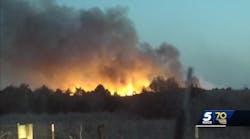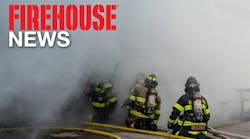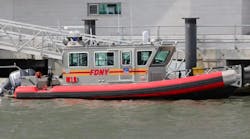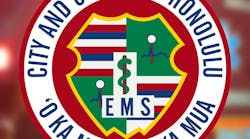A controversial video showing a confrontation between a Connecticut state trooper and a video camera operator raises questions within the fire service about the inherent conflict between the rights to privacy and freedom of the press.
On Dec. 5, 2010, a woman was killed in a single-vehicle crash on Interstate 95 near Fairfield, CT. The car in which she was riding struck a metal railing, spun into traffic and burst into flames. A Connecticut Post video camera operator apparently arrived on scene soon thereafter and began taking video of the scene and fire department operations. Two minutes into the video, a state trooper is seen ordering the camera to cease operations, using foul and abusive language. The video appears to end immediately afterwards.
There is no indication the video was taken from an unsafe location or within any established police perimeter. It apparently was taken in a public place – on a public roadway. There do not appear to be any shots of the victim, just a burning vehicle and fire department operations. However, many in the fire community have objected to the idea of someone taking videos of this tragedy as it was happening.
The courts have widely recognized an individual’s right to privacy in private places, such as a home. Unfortunately, this tragedy occurred in a public place, where the right of privacy must be balanced against other rights, including the freedoms guaranteed under the First Amendment to the U.S. Constitution. This case raises the question of balancing these potentially conflicting rights against one another: When is it appropriate for police (or fire) officials to restrict the right of public access to an area in order to protect an individual’s privacy?
It is within a government’s power to restrict public access when it has a legitimate reason to do so. Two obvious justifications for restricting access are to keep the public safe and to prevent the public from getting in the way of legitimate operations such as firefighting and rescue or police investigations. Police or fire officials, acting as agents of the government, can set up a reasonable perimeter around an accident scene. Presumably, they also could take actions, such as the placement of apparatus, to block a scene from public view. They may also restrict the activities of the public whenever the public is permitted access to a restricted area.
However, as I noted in an earlier column about issues related to firefighters taking on-scene photographs, it is a basic principle of law that anyone may take a photograph or video of anything in a public area (Fire Law, June 2010). Dave Levy, a Chicago, IL, lawyer who formerly was a volunteer firefighter in Maryland, noted in a blog posting about this case, “An agent of the government (the trooper) does not have the constitutional power to tell a private citizen (the cameraman) who is standing on a public street what he can and cannot photograph. That is the heart of the First Amendment.” This is true even if the photos (or video) are in poor taste or offensive to some, which appears to be the objection in this case.
A U.S. District Court in California recently ruled on a similar case. In Chavez v. City of Oakland, an Oakland Tribune photographer came upon a serious personal-injury collision while driving on a freeway. Traffic was blocked, so Chavez left his car on the freeway and went to take pictures. After about 15 minutes, an Oakland police officer ordered him to leave the scene. Chavez asserted his right to cover the accident as a reporter, but was arrested and released with a citation.
Chavez sued the police department, claiming his arrest violated the First Amendment (along with other unrelated claims). The court ruled against Chavez because he did not have the right to be where he was. The judge wrote that “members of the general public are not allowed to exit their cars in the middle of the freeway to view an accident scene.” He did not, however, say categorically that Chavez had no right to be there. If he had parked in a legitimate parking place, the decision might have been different. The decision seems to reaffirm the principle that access may be limited when safety (or operations) is affected. There are many other similar decisions from courts across the country.
Reporters are there to tell a story. We may not like the story or the way it is told, but the First Amendment clearly protects freedom of the press. There always will need for a balance between the rights of the press and the right to individual privacy. While lawyers battle in courts over where to draw the line between these two rights, we in the fire service are on the streets, daily confronting the dilemma of how to handle these potentially controversial scenes. Law enforcement won’t always be there to do it for us, so we need to be prepared with reasonable principles to guide our actions.
Current state laws provide one starting point for developing policies. Some states make specific provision for media access to disaster sites or for family access to a scene. Beyond that, though, fire departments should have policies with a rational basis that reflect the legitimate concerns of the press and victims.
Certainly, departments have the authority to establish a perimeter that limits public access to an incident. Operational priorities supersede rights of the public and the press to have access to an emergency scene. The most important priority is protecting the safety of operational personnel and civilians involved in the incident, as well as bystanders. The courts are likely to approve any reasonable steps taken to improve the safety of those at the scene, but that is not a grant of complete power. A fire department will need to show that its actions were a reasonable means of protecting those involved.
At the scene of any emergency, it is critical to protect the integrity of ongoing operations and investigations. However, this does not give the fire service the unlimited right to hide from the press. If it is necessary to deny the media’s request for access to photograph or video a scene, provide an explanation and seek to find an alternative way to meet their needs. If one location is unsafe, identify a suitable location.
It is inevitable that firefighters will eventually confront the clash of these two basic legal rights. There is no clear answer to the question of how we resolve the conflict nor is there likely to be one. Courts may pass judgment on cases and provide guidance, but we must be prepared to rationally accommodate both interests.
—Steve Blackistone





